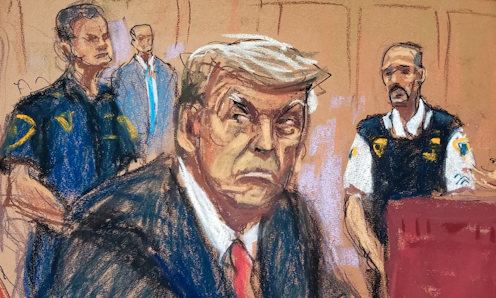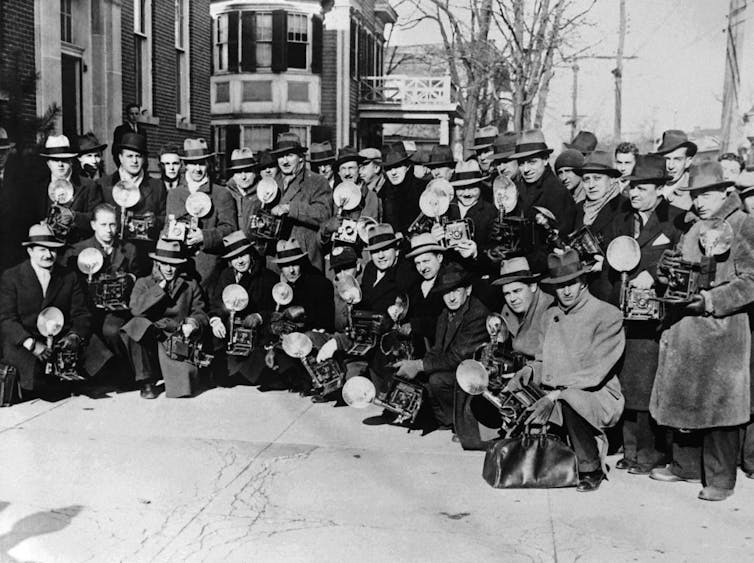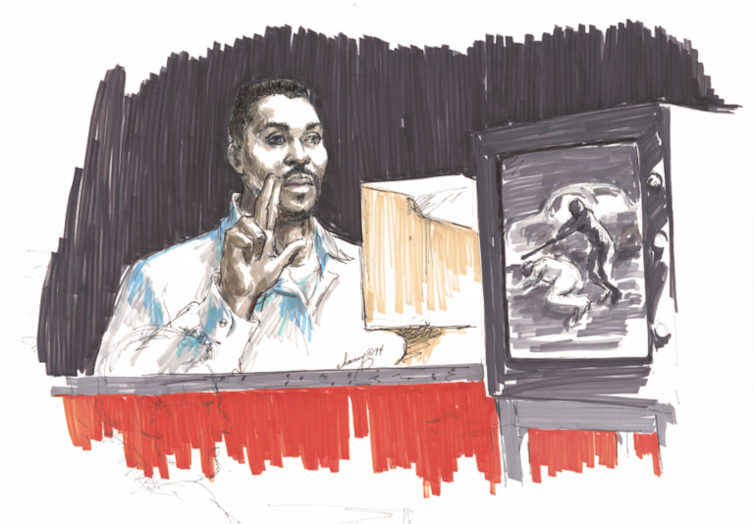
For the first time in its history, The New Yorker featured a courtroom sketch on its cover.
The image, which appears on its April 17, 2023, issue, gives viewers a glimpse of a historic court proceeding that could not be captured by cameras: the arraignment hearing of Donald Trump two weeks earlier.
Because Trump is the first former U.S. president to be criminally indicted, there is immense public interest in this case. However, when Trump pleaded not guilty to 34 felony counts of falsifying business records, his reactions and expressions could be visually recorded only by three approved courtroom artists.
In a way, it was a throwback to an era when only artists could provide the public with visual records of court proceedings. Yet with more and more jurisdictions allowing cameras into courtrooms, courtroom artists now find themselves working in a dying field.
Having studied both courtroom sketches and tabloid crime photography, I sometimes wonder what might be lost if courtroom art were to become extinct.
The history of courtroom sketches
Despite their dwindling numbers, courtroom artists are still able to pursue their craft because many judges continue to forbid photography in their courtrooms.
Yet a national standard for banning cameras in U.S. courtrooms is less than 100 years old.
When news photography flourished after World War I, courtroom photographs became a staple of tabloids such as the New York Daily News. These newspapers regularly sent their reporters to cover high-profile trials, taking advantage of the uneven patchwork of judicial positions on whether cameras should be allowed in courtrooms.
The trial of Bruno Richard Hauptmann spurred a wave of regulations against cameras in courtrooms.
In 1935, Hauptmann was tried for kidnapping and murdering the child of Charles Lindbergh. To cover the so-called “Trial of the Century,” an estimated 700 reporters and more than 130 cameramen rushed to Flemington, New Jersey, leading to reports of photographers climbing on the counsel’s table, shoving their flashbulbs in witnesses’ faces and jockeying with one another to take pictures of Hauptmann.

After investigating the sensational publicity surrounding the Hauptmann trial, the American Bar Association went on to ban courtroom photography in Canon 35 of its 1937 Canons of Judicial Ethics. Following the American Bar Association’s lead, Congress enacted Rule 53 of the Federal Rules of Criminal Procedure in 1944, which prohibited photography in federal courtrooms during judicial proceedings.
This statutory ban remains in place today in American federal criminal courts and in the U.S. Supreme Court.
The bulky cameras of the past, along with their cables, microphones and wires, required judges, witnesses, lawyers and jurors to navigate around them. Today’s cameras, however – whether in their compact, portable form or as remotely controlled, permanently mounted features in courtrooms – operate as less physically disruptive recorders of court proceedings.
Although cameras can give the general public direct access to what happens during a trial, they can also threaten what the American Bar Association has termed the “fitting dignity and decorum” of court proceedings. When cameras are permitted, as they were in the O.J. Simpson trial, judges and lawyers sometimes worry that the proceedings will turn into a circuslike spectacle.
An artistic flash
Because the history of courtroom sketches cannot be separated from the history of prohibiting photography in the courtroom, cameras and human artists are often positioned as competitors in the production of courtroom images.
Working with a print or television news agency, freelance courtroom artists need to draw quickly to meet news deadlines. Notably, courtroom artist Mary Chaney was able to depict, through more than 260 sketches, the criminal and civil trials of the four Los Angeles police officers charged with beating Rodney King.

When courtroom illustrators, such as David Rose, assert that “the camera sees everything, but captures nothing,” they are arguing that the camera’s mechanical eye is a poor substitute for – as Chicago courtroom artist Andy Austin puts it – “the human eye, the human hand, dealing with a human subject for viewing by humans.”
While the camera can immediately generate highly detailed images of a trial, it cannot capture the emotional resonance of a courtroom moment. By funneling the emotional highs and lows of a trial through their body, courtroom artists can bring to their work irreplaceable sensory and dramatic insights.
Part of the drama stems from a courtroom artist’s ability to compress hours of court action into a single drawing. Artists can also manipulate the composition and perspective of their drawings to create “artistic pull.” Even though judges, lawyers, witnesses and the defendant may be physically spread out in the actual courtroom, the artist can bring them into close proximity with one another and the viewer.
It is in this way that courtroom sketches can make viewers feel the emotional pull of the trial’s main characters.
One sketch goes viral
This is what happened in Jane Rosenberg’s viral courtroom sketch of Trump.
Compared with the drawings made by Christine Cornell and Elizabeth Williams, Rosenberg’s image is the only one that depicts Trump looking glum, with his arms crossed as he eyes Manhattan District Attorney Alvin Bragg.
Because Bragg is not visible in the image, it appears as though Trump is fully facing the viewer with an expression that has been simultaneously described as despondent, disdainful and “pissed off.”
To allow viewers to focus even further on Trump’s facial expression and body language, the New Yorker cover crops Rosenberg’s illustration, so that it becomes a portrait of a former president in criminal court. Made up of energetic pastel-chalk lines that are suggestive but ultimately unfinished, the rough sketch aesthetically aligns with the moral “sketchiness” that has long dogged Trump.
The afterlives of courtroom sketches
When Reuters tweeted Rosenberg’s courtroom sketch of Trump, it jump-started the image’s afterlife.
Even though the practice of courtroom illustration has been described as a dying art form, courtroom sketches, like other cultural artifacts, are not only preserved in special collections and exhibits; they can also evolve through successive framings and interpretations.
In our current digital world, courtroom sketches can go viral on social media, especially if the artist fails to accurately capture the likeness of a high-profile, celebrity defendant.
Rosenberg herself is no stranger to creating viral courtroom sketches. When covering Deflategate – the deflated ball controversy involving NFL star Tom Brady – she drew a portrait of the then-New England Patriots quarterback that elicited comparisons to Quasimodo, Lurch and Thriller-era Michael Jackson.
Courtroom sketches can also be creatively transformed into online memes. Rosenberg’s Trump sketch has been photo-edited to evoke Edvard Munch’s “The Scream,” to include a bucket of KFC fried chicken and to appear as if he’d been caught by the Scooby Doo gang.
Trump’s fans and foes may not have gotten their mugshot. But they have a viral courtroom sketch, and what started as an image drawn under a courtroom’s tightly regulated conditions has since taken on a life of its own.
Anita Lam does not work for, consult, own shares in or receive funding from any company or organization that would benefit from this article, and has disclosed no relevant affiliations beyond their academic appointment.
This article was originally published on The Conversation. Read the original article.







